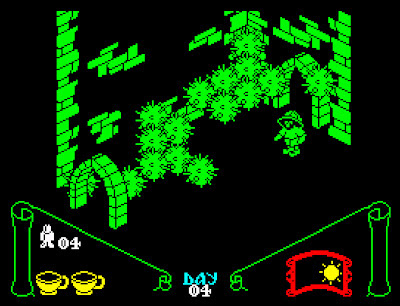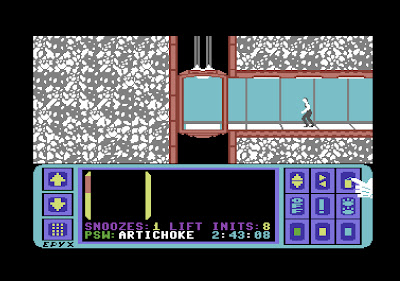 |
| Morkin takes a last look back at his companions before a lonely trek north in search of the Ice Crown. |
It can’t be very often that a game crammed in
to 48k of memory can be called epic but The
Lords of Midnight certainly is. It
is a turn-based strategy cum wargame set across 4,000 locations. Mike Singleton
used a scaling technique he call Landscaping that allowed the player to look in
8 directions from each location. This
gave a total of 32,000 unique views which was a revelation, not to mention a
big selling point, back in 1984.
The aim of the game is to defeat Doomdark the
witchking who controls the northern half of the land of Midnight. He has cast a spell of cold over the land and
defeating him is the only way to free it.
You start the game at the Tower of the Moon initially controlling 4
characters including Luxor
the Moonprince and his son Morkin. The
game world is seen through the eyes of the character you currently have
selected.
Doomdark can be defeated in two ways. Firstly Morkin can be sent north to the Tower of Doom to destroy the Ice Crown which is
the source of Doomdark’s power. Morkin
is half human, half fey and by virtue of his ancestry is immune to the Ice Fear
and is the only character able to get close to the crown without
detection. The Ice Fear is a power that
emanates from the Ice Crown and will sap the strength and morale of friendly
armies.
The second way to defeat Doomdark is by
taking his home Citadel of Ushgarak by force.
You can send out your characters to friendly citadels and keeps across
the land of Midnight recruiting armies to fight for
your cause. Not all Lords can be
persuaded to join, for example starting character Corleth the Fey is the only
one able to persuade the forest dwelling Fey to join your quest.
 |
| The newly recruited Lord of Gard in the far south is not yet affected by the Ice Fear. |
For Doomdark to win the game he must defeat
the armies of the Free by killing Luxor or taking Xajorkith, the citadel of the
Free. He must also kill Morkin for as
long as he is alive the game can still be won.
All your allies (apart from Morkin) are
controlled via the Moon Ring which is worn by Luxor. The Moon Ring also radiates a warmth
that lessens the effects of the Ice Fear on anyone close to it. Unfortunately, because of this, Doomdark can
sense the location of its wearer. If Luxor should die you will
lose control of the armies of the Free.
The only way to regain control is for Morkin to retrieve the ring from
the location in which Luxor
fell. This will mean Doomdark will know where his is, making his own quest that
much more difficult.
Dotted around the landscape are features
including ruins, henges, magical lakes, liths and caves which can help or hinder
the player. For example a cave may
provide shelter, but it can just as easily be hiding a monster such as the
dragons, wolves and ice trolls which roam the land.
 |
| Searching ruins can prove fruitful. |
This game can’t be criticised for its sound
because there isn’t any. The graphics,
while obviously dated, are still quite effective. What is unchanged is the game play which is
as good and as challenging as ever. It’s
not a game I have completed and not one I am likely to complete in the near
future. However my 15 year old self did
map the land of Midnight using pages liberated from my
maths exercise book (I still have it) so I will probably give it another go at
some point.
 |
| At night your opponents make their moves. |
 |
| Bugger. |
The screenshots and review are for the Spectrum version. The game was also converted to the Amstrad CPC (1984) and Commodore 64 (1985) and plays more or less identically on these machines.

























